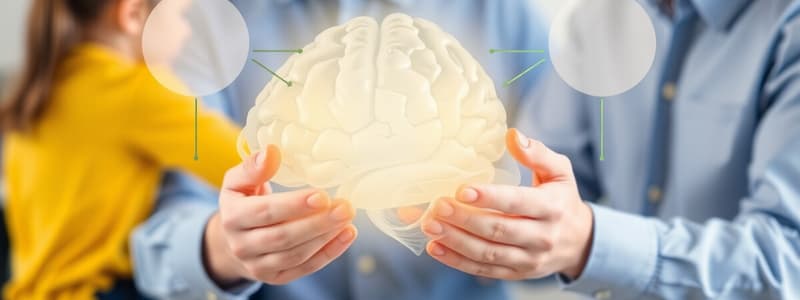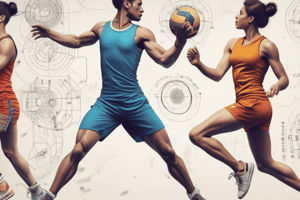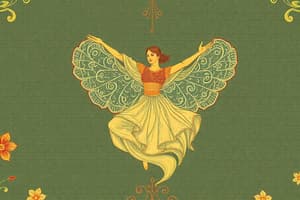Podcast
Questions and Answers
What is the primary focus of coaches when developing athletes?
What is the primary focus of coaches when developing athletes?
- Developing a solid foundation of basic skills (correct)
- Encouraging competition without skill development
- Focusing solely on physical fitness
- Introducing advanced techniques immediately
Internally paced skills are controlled by external factors.
Internally paced skills are controlled by external factors.
False (B)
What are the three phases of motor learning according to the Fitts and Posner model?
What are the three phases of motor learning according to the Fitts and Posner model?
Cognitive, Associative, Autonomous
In the _______ stage, movements are fluid and well-coordinated.
In the _______ stage, movements are fluid and well-coordinated.
Match the type of skill to its characteristics:
Match the type of skill to its characteristics:
During which phase is feedback crucial for correcting errors?
During which phase is feedback crucial for correcting errors?
Athletes in the Autonomous Stage focus primarily on technique rather than decision-making.
Athletes in the Autonomous Stage focus primarily on technique rather than decision-making.
What type of feedback becomes more prominent during the Associative Stage?
What type of feedback becomes more prominent during the Associative Stage?
What is a characteristic of skilled performers compared to unskilled performers?
What is a characteristic of skilled performers compared to unskilled performers?
Cognitive skills exclusively involve physical movements.
Cognitive skills exclusively involve physical movements.
Name one type of motor skill that involves large muscle groups.
Name one type of motor skill that involves large muscle groups.
Fine motor skills involve ______ muscle groups and precise movements.
Fine motor skills involve ______ muscle groups and precise movements.
Match the types of skills with their descriptions:
Match the types of skills with their descriptions:
Which of the following identifies a characteristic of motor skills?
Which of the following identifies a characteristic of motor skills?
An example of a closed skill is playing soccer.
An example of a closed skill is playing soccer.
What factor influences the development of motor skills?
What factor influences the development of motor skills?
What is a characteristic of a simple task learning curve?
What is a characteristic of a simple task learning curve?
Plateaus in performance improvement can indicate a limit to an athlete's ability.
Plateaus in performance improvement can indicate a limit to an athlete's ability.
What are the three main types of cues used to improve performance?
What are the three main types of cues used to improve performance?
A __________ occurs when performance shows no improvement despite continued practice.
A __________ occurs when performance shows no improvement despite continued practice.
Which type of cue is considered the most effective for introducing new skills during the cognitive phase?
Which type of cue is considered the most effective for introducing new skills during the cognitive phase?
Internal cues only come from external environments.
Internal cues only come from external environments.
Match the following types of cues with their definitions:
Match the following types of cues with their definitions:
The degree of learning can be measured through __________ analysis.
The degree of learning can be measured through __________ analysis.
What is the primary function of visual cues in performance?
What is the primary function of visual cues in performance?
Proprioceptors provide feedback only about a performer's external environment.
Proprioceptors provide feedback only about a performer's external environment.
What are the four stages of the information processing model?
What are the four stages of the information processing model?
The __________ mechanism is influenced by the ability of sense organs.
The __________ mechanism is influenced by the ability of sense organs.
Which of the following best describes verbal cues?
Which of the following best describes verbal cues?
Match the following cues with their descriptions:
Match the following cues with their descriptions:
High-level performers do not utilize visual cues for decision-making.
High-level performers do not utilize visual cues for decision-making.
What role do coaches play in the use of verbal cues?
What role do coaches play in the use of verbal cues?
What type of feedback is described as information received from outside the body?
What type of feedback is described as information received from outside the body?
Positive feedback can sometimes be demotivating for athletes.
Positive feedback can sometimes be demotivating for athletes.
What type of feedback is given during performance to allow for immediate adjustments?
What type of feedback is given during performance to allow for immediate adjustments?
_________ feedback highlights areas for improvement and can be constructive.
_________ feedback highlights areas for improvement and can be constructive.
Match the type of feedback with its description.
Match the type of feedback with its description.
Which feedback is typically focused on the quality of movement?
Which feedback is typically focused on the quality of movement?
Terminal feedback is provided during performance.
Terminal feedback is provided during performance.
What is the role of motivational feedback?
What is the role of motivational feedback?
Flashcards are hidden until you start studying
Study Notes
Definition of Skill
- Skill is the learned ability to achieve predetermined results with maximum certainty, often with minimal time or energy expenditure.
- Skills are classified into cognitive, perceptual, and motor, each involving various cognitive and physical processes.
- Cognitive skills involve mental processes.
- Perceptual skills relate to how individuals interpret stimuli from their environment.
- Motor skills involve physical movements, crucial in sports and physical activities.
Characteristics of Motor Skills
- Motor skills involve complex movement sequences learned through practice.
- Skilled performers demonstrate accuracy, speed, and coordination.
- Skilled individuals analyze information and make decisions quicker.
- Physiological efficiency is a characteristic of skilled performance, characterized by fluid and economical movements.
Classification of Motor Skills
- Gross Motor Skills involve large muscle groups and whole body movements.
- Fine Motor Skills involve smaller muscle groups and precise movements.
- Open Skills are performed in changing environments, requiring adaptation.
- Closed Skills are performed in stable environments with predictable outcomes.
- Discrete Skills have clear beginnings and endings.
- Serial Skills are composed of a series of discrete skills performed in sequence.
The Pacing Continuum
- Internally Paced Skills are initiated by the performer, with timing controlled by the athlete.
- Externally Paced Skills are influenced by external factors, with timing dictated by the actions of others.
Phases of Motor Learning
- Cognitive Phase: The performer learns the task's nature and requirements. Performance is inconsistent and characterized by frequent errors.
- Associative Stage: Extensive practice develops motor programs. Skills become more automatic and consistent.
- Autonomous Stage: Movements are fluid and well-coordinated. Performers respond quickly and accurately, focusing on decision-making.
Learning Curves and Performance Measurement
- Simple Task Learning Curve shows rapid improvement with practice, leveling off as the skill is acquired.
- Complex Task Learning Curve depicts slower initial improvement, with gradual progress.
- Plateaus indicate stalled performance improvement despite continued practice, serving as a period of skill consolidation or a limit to the athlete's ability.
Types of Cues Used to Improve Performance
- Visual Cues: External signals helping performers understand and execute skills. Demonstrations are crucial for introducing new skills.
- Verbal Cues: Instructions or feedback guiding performers in executing a skill.
- Proprioceptive Cues: Involve the body's sense of position and movement, helping athletes adjust actions based on internal feedback.
Phases of Information Processing
- Input: Sensory system detects signals from the environment. Information is received through sight, sound, touch, proprioception, and equilibrium.
- Processing: Analyzing and interpreting data received. This stage includes three processes: Perceptual mechanism, Decision-making mechanism, and Effector mechanism.
- Output: Motor commands are sent to muscles, resulting in movement.
- Feedback: Provides information about performance, crucial for learning and improvement.
Types of Feedback
- Internal Feedback: Information from sensory receptors within the body.
- External Feedback: Information received from outside the body.
- Concurrent Feedback: Given during performance, allowing for immediate adjustments.
- Terminal Feedback: Provided after performance, useful for future improvements.
Forms of Feedback
- Knowledge of Performance: Subjective feedback focusing on the quality of movement or technique.
- Knowledge of Results: Objective feedback regarding the success of performance outcomes.
- Positive Feedback: Recognizes and reinforces successful actions, crucial for motivation.
- Negative Feedback: Highlights areas for improvement, providing actionable insights.
Functions of Feedback
- Motivational: Encourages performers to strive for improvement by setting achievable goals.
- Performance Change: Informs performers about changes needed for future attempts.
Studying That Suits You
Use AI to generate personalized quizzes and flashcards to suit your learning preferences.




